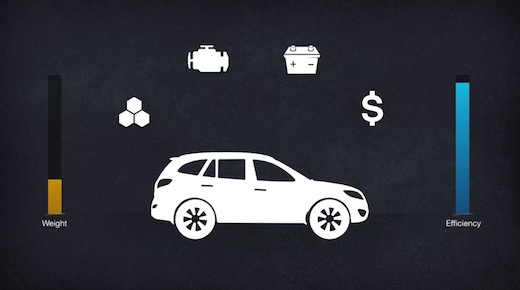“Vehicle fitness” is a prerequisite for electric mobility
On April 28, 2017, the University of Michigan Energy Institute hosted Amory Lovins, Chairman & Chief Scientist of the Rocky Mountain Institute, as a guest lecturer on the topic of the future of automotive design. Central to Lovins’ projections was the principle of “vehicle fitness,” referring to vehicle mass and “slippery” design.
He proposed an iterative approach to vehicle design, focusing first on ways to eliminate unnecessary mass. This reduces the demand on the powertrain and fuel supply, because less power – and therefore less energy – is needed to accelerate less mass. As a result, further weight savings can be realized, since less structure is needed to support the smaller powertrain. This further reduces the load (i.e., inertia and friction) enabling further downsizing of the engine and fuel supply. Lovins describes this as a virtuous cycle, in which material costs plunge. These savings can finance the cost of transitioning to electrified powertrains (i.e., via hydrogen fuel cells, batteries), as well as advanced, ultralight materials.
According to the Rocky Mountain Institute’s analysis, fitter vehicles combined with electrification (whether hydrogen-based on plug-in) can contribute to a global transportation system that costs much less while enabling much more mobility for people and goods.
The Tech-K.O. Takeaway: This goes to show that achieving cost-effective electrified transportation is as much about reducing vehicle mass and other loads as it is about motors and batteries.
- Watch or download Amory Lovins’ presentation: “Astonishing Automotive Futures: Disruptive Designs, Analyses, and Strategies.”
- Image: Lighter materials → smaller engine → smaller battery → cheaper cost. Slide 25 from “Astonishing Automotive Futures: Disruptive Designs, Analyses, and Strategies” (Amory Lovins).

